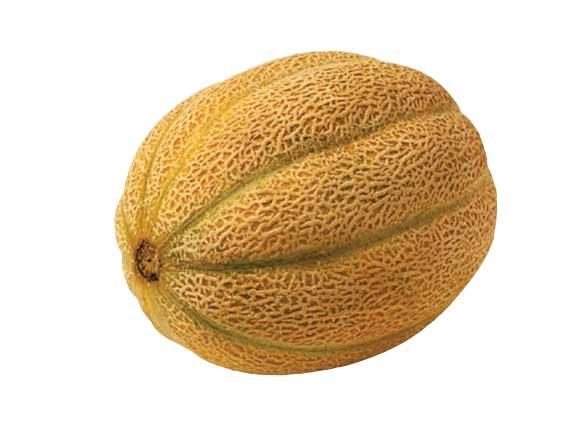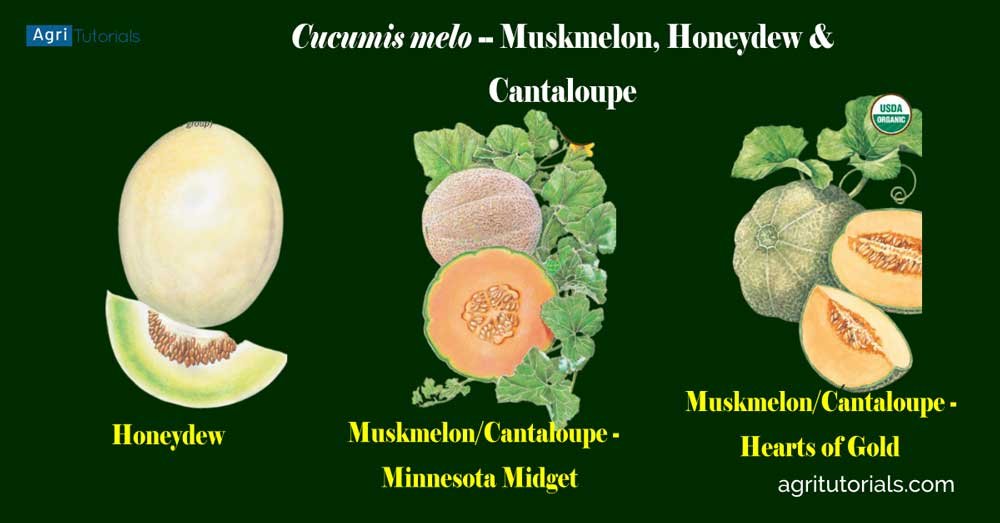Grow Honeydew Melon: One of the two primary cultivar varieties of the Cucumis melo Inodorus Group is the honeydew melon. The wrinkle-rind casaba melon differs from the former in that it has a smooth rind and no musky smell.
| Honeydew: | A melon of a variety with smooth pale skin and sweet green flesh i.e., called Honeydew Melon. |
| Species: | Cucumis melo |
| Cultivar group: | Inodorus group |
| Origin: | Spain, Southern France, Algeria |
| Honeydew Meaning in Hindi: | खरबूज़ा |
| Nutrition: | Carbohydrates, Fat, Protein, Vitamins, Minerals |
| (a) Vitamins: | Vitamin B – [Thiamine (B1), Riboflavin (B2), Niacin (B3), Pantothenic acid (B5), Vitamin (B6), Folate (B9)], Vitamin C and Vitamin K |
| (b) Minerals: | Calcium, Iron, Magnesium, Manganese, Phosphorus, Potassium, Sodium and Zinc. |
Is Melons Easy to Grow?
It’s not too difficult to grow honeydew melons at home. You can effectively cultivate honeydew in your garden if you take good care of it. In warm climates with ample of sunshine, honeydew thrives. You can still grow honeydew if you live in a cool climate, although it can take longer for the fruit to ripen. Select a location in your garden that receives direct sun exposure to make sure your melon plant receives enough warmth.

Characteristics of Honeydew Melon
- A honeydew is approximately 15-22 cm (5.9-8.7 in) long and has a round to slightly oval form. It typically weighs between 1.0 to (4.5 to 7.9 lb) 3.6 kg .
- The smooth peel can be either greenish or yellow, but the flesh is typically a light green tint.
- It has seeds, much like most fruit. In supermarkets or marts, it is frequently available in the green veggie produce or fruit area. The inside flesh is consumed, frequently as dessert.
Nutrition:
- Vitamins: Vitamin B – [Thiamine (B1), Riboflavin (B2), Niacin (B3), Pantothenic acid (B5), Vitamin (B6), Folate (B9)], Vitamin C and Vitamin K
- Minerals: Calcium, Iron, Magnesium, Manganese, Phosphorus, Potassium, Sodium and Zinc.
How to Grow Honeydew in Your Garden Area
Site Selection
- Watermelons in particular are vining crops that need a lot of room to grow.
- They should only be cultivated in larger gardens in rural areas or lots-size gardens in urban areas because they are not well suited to small gardens.
- If the fruit is supported and the vines are trellised, musk melons can be cultivated in small gardens.
- Deep, well-drained, sandy or sandy loam soil with lots of organic matter is ideal for growing melons.
- Clay-rich, heavy soils can result in small, frail plants that yield fewer musk melons.
- musk melons love soils with a pH of around 7, and plants will lose their flowers if the soil is too acidic.
Soil Preparation
In the winter or early spring, plough or dig the ground 8 to 10 inches deep. If manure or organic matter is introduced, it needs to be properly composted. To increase the amount of organic matter in the soil, apply manure or compost at a rate of 50 to 100 pounds per 1,000 square feet, or roughly 2 to 4 tons per acre. Make sure all organic materials is completely covered by turning the soil over.
Work on the soil, make into small ridges or hills 4 to 8 inches high and 12 to 14 inches wide for planting since melons need well-drained soils. Higher ridges are needed for heavier soils. Place the rows of watermelons, honeydew, and muskmelons 6 to 8 feet apart. The rows of irrigated watermelons should be 10 to 12 feet apart.
Seeding Pattern of Honeydew in Garden area or in A Pot
- It is preferable to start with seeds if you want to grow honeydew in your garden. A ripe honey dew melon’s seeds can be collected, or you can buy honeydew seeds online or from a garden centre.
- Fill a seed [into small ridges or hills 4 to 8 inches high and 12 to 14 inches wide], if you are using tray or pot, some of the special action can take place i.e. with moistened potting soil before planting the seeds. Place the seeds on the mixture’s surface, then softly cover them with additional mixture. Place the tray or container in a warm, sunny position and lightly water the seeds.
- The seeds ought should begin to sprout in 8 – 10 days. When the seedlings first appear, thin them out until only the strongest ones are left.
- When the seedlings are 4-6 inches tall, transplant them into separate pots or directly into the garden. To thrive, melon need full sun and well-drained soil.
- Regularly water the plants, especially in hot, dry weather. To encourage healthy growth, fertilize the plants every two to three weeks with a balanced fertilizer.
- To ensure proper fruit set as the plants begin to bloom, you can hand-pollinate the blooms. Transfer pollen from the male flowers, which lack petals, to the female flowers to accomplish this (which have petals).
- After pollination, the fruits will begin to ripen in two to three months. When honey dew melons are deep green in colour and emit a pleasant aroma, they are mature. Utilize a sharp knife to separate the fruit from the vine.
Varieties : Honeydew, Muskmelon & Watermelon
Honeydew Varieties
Honey Girl
Sweet Delight
TAM Dew
Muskmelon Varieties
Mission
Perlita
TAM Uvalde
Caravelle
Israeli
Mainstream
Hale’s Best
Magnum 45
Ambrosia
Watermelon Varieties
Charleston Gray
Jubilee
Mickylee
Allsweet
Royal Jubilee
Tendersweet
Mirage
Black Diamond
Crimson Sweet
Seedless Watermelon Varieties
Tiffany
Tri-X 313
Online Availability of Seeds
Use of Fertilizer
Small doses of fertilizer applied twice or three times are the best for growing melons. For optimal results, apply fertilizer in a band down the row. Small doses of fertilizer applied twice or three times are the best for growing melons. For optimal results, apply fertilizer in a band down the row.
Apply a phosphorous-rich fertilizer, such as 10-10-10, to watermelons at a rate of 4 pounds per 1,000 square feet (60 to 90 feet of row). On the planting bed, dig a trench that is 4 to 6 inches deep and 2 inches from the row’s side. Plant while covering the fertilizer to prevent the seeds from touching it. Spread 2 to 3 pounds of fertilizer per 60 to 90 feet of row, 2 to 3 feet to the side, and lightly mix it with the soil before the runners on the vines are approximately 6 inches long.
Insects Name, description and Control
Name: Spider mites: barely visible to naked eye; spiderlike; suck juice from undersides of leaves; may form tiny webs; leaves lose color
Control: Beneficial insects, strong blasts of water, insecticidal material, neem oil
Name: Cucumber beetle: Adult half inches long; yellow to black with black spots or three stripes on back; feeds on stems, leaves and fruit; transmits bacterial wilt; larvae bore into root and stem below soil line
Control: Sevin pyrethrins
Name: Aphids: half inch long; soft bodied; green, pink, red or brown; usually on undersides of leaves; suck plant juices
Control: Neem oil & insecticidal material
After Planting and Harvesting
Plants, melon grow from the ground 10 to 12 days after sowing. Trim the plants to three to four per hill after they are in place. Re-thin the plants after they have two or three leaves, leaving two plants per hill. Another thinning is frequently not necessary due to insect or other damage.
Keep weeds away from the plants, particularly in the spring when the plants are just starting to grow. Avoid cutting too deeply into the soil when hoeing close to the melon plants to prevent damaging the roots.
Bees are required to cross-pollinate the flowers on melon plants because each plant has distinct male and female flowers. A common issue with watermelons is inadequate pollination, which results in female flowers falling off the vines or fruits that are poorly shaped.
Pruning watermelons to two fruits per plant for large kinds or four to six fruits per plant for small varieties will increase the size of the fruit.
Muskmelon fruits can be pruned to make them bigger, but this is not typically necessary. Read the label of a pesticide before using it. Always heed the warnings, guidelines, and precautions.
Muskmelon and History
The muskmelon are indigenous to Persia (Iran) and the surrounding regions to the west and east. It is thought that Persia and the trans-Caucasus served as the primary origin and development centres, with Afghanistan, Kashmir, and the northwest provinces of India serving as a subsidiary focus. Several closely related wild species have been observed in those areas, despite the fact that true wild forms of Cucumis melo have not yet been discovered.
Like watermelon, the muskmelon (Cucumis melo) is rarely a vegetable, but it is a significant crop for gardens and trucks. In America, it’s common to refer to musk melons as simply “melons,” although this is misleading because watermelons are also frequently referred to as “melons.”
The Honey Dew, Casaba, and Persian variants are just a few examples of the Melons that have many shapes, sizes, and fresh characteristics of musk melons but should not be named as “cantaloupes.” Watermelon, cucumber, pumpkin, and squash cannot cross with musk melon, although cultivars of the same species can.
Because of the delicious aroma of the ripe fruits, mus kmelons get their name. The word melon is French and comes from the Latin word melopepo, which means “apple-shaped melon” and is derived from words with a similar meaning in Greek. Musk is a Persian word for a particular type of perfume.

Difference between Muskmelon, Honeydew melon & Cantaloupe?
- The real cantaloupes are European melons with hard shells. The skin is smooth, the flesh is green, and the aroma is noticeably different in honey dew melons compared to musk melons.
- Honey dews, as opposed to muskmelons, can be kept for up to a month. While hone ydews will continue to ripen a little after being harvested from the vine, vine-ripening is preferred for musk melons.
- Black plastic mulch can be used to warm the soil and prevent weed growth in cool climates. Melons require a lot of water to thrive, but they taste best when allowed to ripen in a dry environment.
- To protect ripening fruit from moisture damage, place it on a bed of soft straw or a coffee can. Melons grow well on trellises as well because they conserve space and improve airflow, both of which help ward off fungus illnesses.
- The small, oval, densely netted kind of muskmelon known as a cantaloupe is the most common variety in America. All cantaloupes are musk melons, but not all muskmelons are cantaloupes.



